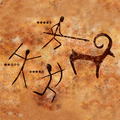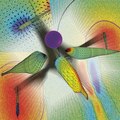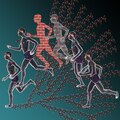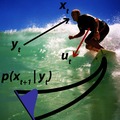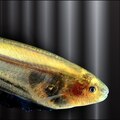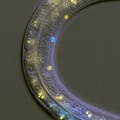User:Daniel Mietchen/Sandbox/PLOS Computational Biology
| Discipline | Computational biology |
|---|---|
| Language | English |
| Edited by | Ruth Nussinov (ORCiD 0000-0002-8115-6415) and Jason Papin (ORCiD 0000-0002-2769-5805) |
| Publication details | |
| History | 2005–present |
| Publisher | Public Library of Science (United States) |
| Frequency | Daily |
| Yes | |
| License | Creative Commons Attribution License |
| 4.542 (2017) | |
| Standard abbreviations | |
| ISO 4 | PLOS Comput. Biol. |
| Indexing | |
| ISSN | 1553-734X (print) 1553-7358 (web) |
| LCCN | 2004216490 |
| OCLC no. | 57176662 |
| Links | |
PLOS Computational Biology is an open access peer-reviewed computational biology-focused journal established in 2005 by the non-profit organization Public Library of Science (PLOS). Out of the eight PLOS journals, it is one of the four "community journals" (along with PLOS Genetics, PLOS Pathogens, and PLOS Neglected Tropical Diseases). As with all journals of the Public Library of Science, PLOS Computational Biology is financed through publication fees, and offers fee support opportunities.
The journal is run by an international Editorial Board. The founding Editor-in-Chief was Philip Bourne (University of Virginia, USA), along with founding Editors Steven E. Brenner (University of California- Berkeley, USA) and Michael Eisen (University of California- Berkeley, USA). The current Editors-in-Chief are Ruth Nussinov (National Cancer Institute, USA and Tel Aviv University, Israel) and Jason Papin (University of Virginia, USA).
PLOS Computational Biology is an official journal of the International Society for Computational Biology (ISCB).[1]
Journal[edit]
Scope[edit]
The journal scope of PLOS Computational Biology is to feature works of exceptional significance that further our understanding of living systems at all scales—from molecules and cells, to patient populations and ecosystems—through the application of computational methods. Readers include life and computational scientists, who can take the important findings presented here to the next level of discovery.
Generally, reliability and significance of biological discovery through computation should be validated and enriched by experimental studies. Inclusion of experimental validation is not required for publication, but should be referenced where possible. Inclusion of experimental validation of a modest biological discovery through computation does not render a manuscript suitable for PLOS Computational Biology.
Contents[edit]
PLOS Computational Biology contains several sections and article types. Research Articles are sub-categorised into one of the following three categories: General, Methods or Software.
As well as research articles PLOS Computational Biology publishes Editorials, Education Articles, Formal Comments, Messages from ISCB, Perspectives, Reviews, Ten Simple Rules, and Topic Pages.
Metrics[edit]
PLOS uses Article-Level Metrics (ALMs) to measure the impact of articles based on their individual merits rather than using the journal impact factor [2]. Traditionally, the impact of research articles has been measured by the publication journal, but this particular view is one that examines the overall performance and reach of the articles themselves. ALMs are noted on each article to mark how often they are viewed, cited, saved, discussed/shared or recommended in order to assess work at the article level.[3]
ALMs are available, upon publication, for every article published by PLOS.
Abstracting and Indexing[edit]
The journal is indexed in PubMed Central[4], PubMed, and Web of Science.
Open Access[edit]
PLOS is committed to ensuring the availability of materials that underpin any articles published in PLOS journals. PLOS's ideal is to make all readily replaceable materials relevant to a given article immediately available without restrictions wherever legal/ethical (while not compromising confidentiality in the context of human-subject research) [5].
The Creative Commons Attribution (CC BY) License is applied to all items published in PLOS Computational Biology[6]. Under the CC BY License, authors retain ownership of the copyright for their article, but authors allow anyone to download, reuse, reprint, modify, distribute, and/or copy articles in the journal, so long as the original authors and source are cited. Under this licence no permission is required from the authors or the publishers [5].
Community Engagement[edit]
PLOS Biologue: PLOS Biologue is a channel for the PLOS journal teams and guest bloggers to engage with the readers, research and non-research audiences on topics ranging from open access publishing development and science policy, to science outreach and education.
Focus Features: Focus Features are chosen by our editors to ‘shape a debate’ on a topic of interest to the computational biology community, encouraging community discussion as well as providing a useful resource on the selected topic.
E-Book: An E-book is a collection of PLOS Computational Biology Education articles on a particular subject which reads as a "book" and is designed to be used as a reference or tutorial for a graduate level introductory course.
Field Reports: Field Reports is a collaborative community blog with posts contributed from researchers attending Computational Biology events from all over the world.
Topic Pages: Topic Pages are broad review articles that are are dual-published both in the journal (as a copy of record) and Wikipedia, acting as a living document that will be updated and enhanced by the Wikipedia community. See the introductory Editorial and blog post as well as a more recent case study[7] and PLOS Computational Biology's Topic Pages Collection.
Ten Simple Rules: "Ten Simple Rules" provides a quick, concentrated guide for professional challenges that research scientists may face in their careers.
Twitter: Community members can follow PLOS Computational Biology for news and updates on the social networking service Twitter under the username handle @PLOSCompBiol.
PLOS Science Wednesday: PLOS Science Wednesday is a weekly science communication series featuring live, direct chats with PLOS authors on Science - Reddit (/r/science), an online gathering place for researchers, students and others interested in science.[8]
Gallery[edit]
All figures and images from PLOS Computational Biology are published under a Creative Commons Attribution License for maximum reuse, with attribution, in places other than the journal's website, e.g. to illustrate Wikipedia articles.
-
Principles and Overview of Samping Methods for Modeling Macromolecular Structure and Dynamics
-
Social Norms of Cooperation in Small-Scale Societies
-
Computer Simulation Imply Forelimb-Dominated Underwater Flight in Plesiosaurs.
-
Electric Imaging through Evolution, a Modeling Study of Commonalities and Differences.
-
Prospective Optimization with Limited Resources
-
Decomposition into basic mechanical units of the cowpea chlorotic mottle virus (CCMV) capsid.
-
Visualization of an ant trail pattern.
-
Fear (not)!.
-
Endurance runners must race long distances without 'hitting the wall'
-
Bayesian surfing.
-
Stimulation of the electroreceptors of E. virescens.
-
Cell fate specification in C. elegans.
-
Local fitness environments along an evolutionary path
-
Raytracing of a neuron.
-
An electronic nose estimates odor pleasantness.
-
A bat in flight.
References[edit]
- ^ https://www.iscb.org/journal-list
- ^ http://www.lagotto.io/plos//
- ^ http://www.sparc.arl.org/sites/default/files/sparc-alm-primer.pdf
- ^ https://www.ncbi.nlm.nih.gov/pmc/journals/328/
- ^ a b "Data availability". PLOS. Retrieved 17 May 2016. Cite error: The named reference "PLOS" was defined multiple times with different content (see the help page).
- ^ Bourne, P.E.; Fink, J.L.; Gerstein, M. (2008). "Open Access: Taking Full Advantage of the Content". PLoS Computational Biology. 4 (3): e1000037. doi:10.1371/journal.pcbi.1000037. PMC 2275780. PMID 18369428.
{{cite journal}}: CS1 maint: unflagged free DOI (link) - ^ https://blog.wikimedia.org.uk/2014/03/publishing-scholarly-papers-with-and-on-wikipedia/
- ^ https://www.reddit.com/r/science/search?q=PLOS+Science+Wednesday&sort=new&restrict_sr=on


